Our architectural highlights from the Royal Academy Summer
Exhibition
The annual Summer Exhibition at London’s Royal Academy, now in its 256th year, is a lot. With 1,710 works on show there’s a real mix of the good, the bad, and the ugly. We put in the leg work for you to find a few of the show’s highlights that present & play on architecture or the built environment, across photography, film, cross-stitch, collage & paint.
A year ago on recessed.space we looked at the Peter Barber-curated architecture room of the Royal Academy Summer Exhibition (see 00103). This year, we look for architecture everywhere else across the salon-style hang of eclectic artwork.
The Summer Exhibition is a strange beast. Yes, it is democratic, in that anybody can pay £40 for their work to be passed along a human conveyor-belt in front of selected artist-curators, but it in many ways is not democratic in that each year many of the works on show are if not by the same artists, eerily similar in vibe and approach. Like many British institutions, it has the pretence of everybody having equal opportunity, but some are more equal than others. That said, there are fun and interesting works to be found amongst the works on display - this year totalling 1,710.
Architecture is central to the Royal Academy, though the relationship between architecture and art has been awkward since the 1700s, perhaps reflecting wider cultural angst between the two overlapping but distinct disciplines. The Architecture Room (or, in Assemble’s curation this year, two rooms) at the Summer Exhibition is always somewhat anachronistic to the wider hang, and rather than celebrating open-access formal and aesthetic release as the main show does - for good and bad - it tends to be more insular and often seemingly presents more to other architects than a general public.
It is often the case that more interesting perspectives on architecture, landscape, and the urban can be found not through the eyes of an architect, but the artists displayed across the Summer Exhibition’s other spaces, which is where all of this year’s recessed.space selection come from:
The Summer Exhibition is a strange beast. Yes, it is democratic, in that anybody can pay £40 for their work to be passed along a human conveyor-belt in front of selected artist-curators, but it in many ways is not democratic in that each year many of the works on show are if not by the same artists, eerily similar in vibe and approach. Like many British institutions, it has the pretence of everybody having equal opportunity, but some are more equal than others. That said, there are fun and interesting works to be found amongst the works on display - this year totalling 1,710.
Architecture is central to the Royal Academy, though the relationship between architecture and art has been awkward since the 1700s, perhaps reflecting wider cultural angst between the two overlapping but distinct disciplines. The Architecture Room (or, in Assemble’s curation this year, two rooms) at the Summer Exhibition is always somewhat anachronistic to the wider hang, and rather than celebrating open-access formal and aesthetic release as the main show does - for good and bad - it tends to be more insular and often seemingly presents more to other architects than a general public.
It is often the case that more interesting perspectives on architecture, landscape, and the urban can be found not through the eyes of an architect, but the artists displayed across the Summer Exhibition’s other spaces, which is where all of this year’s recessed.space selection come from:
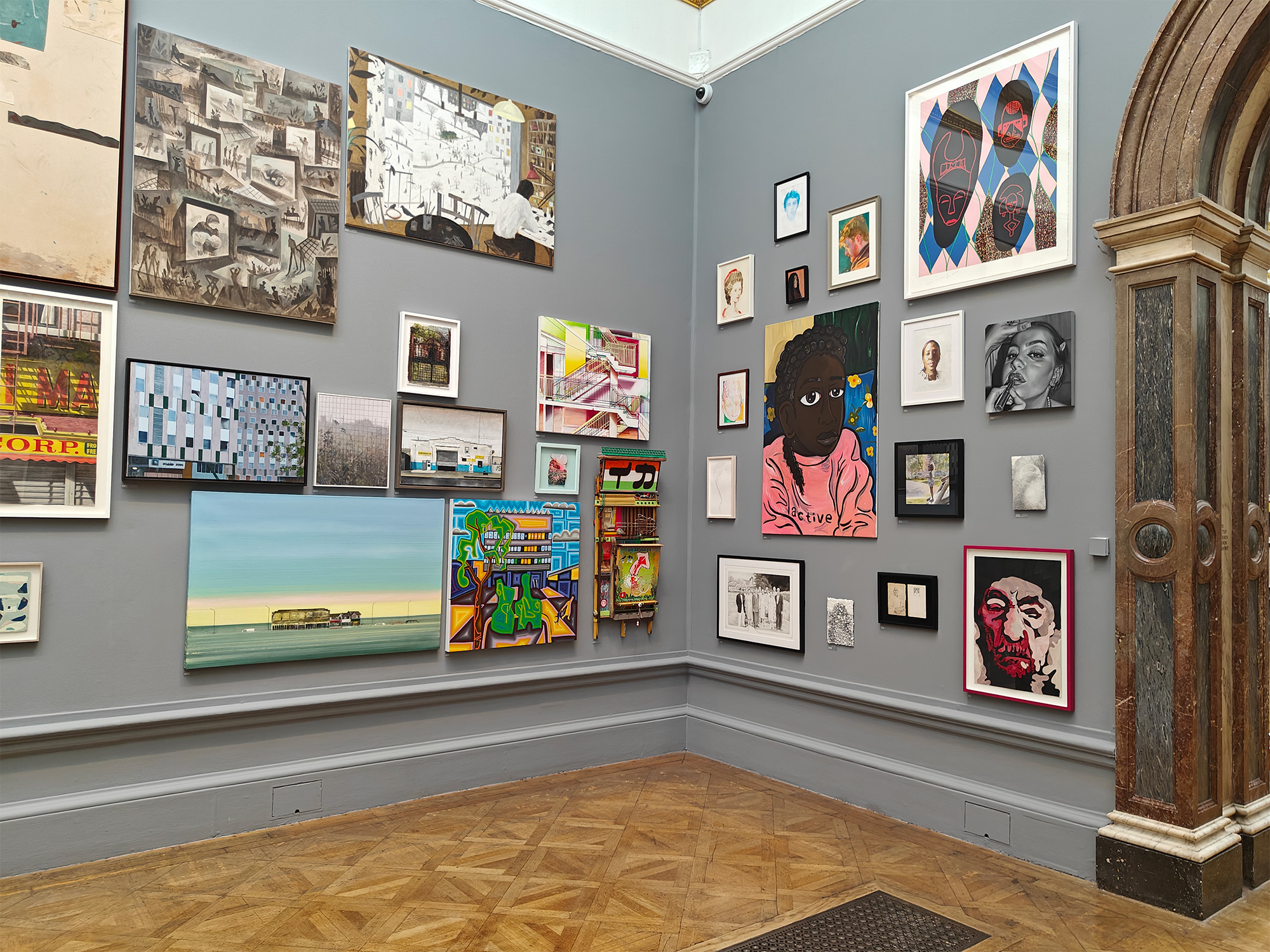
This year’s Summer Exhibition selection committee was formed of artists Hughier O’Donaghue, Cornelia Parker, Veronica Ryan, Hurvin Anderson, Anne Desmet, and Ann Christopher, with architecture collective Assemble in charge of the two architecture rooms.
This work relates to the artist’s 2016 New York Metropolitan Museum project which three years later was reconfigured for the Royal Academy - and while many may say it’s brave or overly-confident to not only put one’s own work so large and central in a self-curated space, not least facing off against a work against the late and great Richard Serra, it is at least a strong-enough work to hold its own in one of the largest Academy gallery spaces.
.
This work relates to the artist’s 2016 New York Metropolitan Museum project which three years later was reconfigured for the Royal Academy - and while many may say it’s brave or overly-confident to not only put one’s own work so large and central in a self-curated space, not least facing off against a work against the late and great Richard Serra, it is at least a strong-enough work to hold its own in one of the largest Academy gallery spaces.
.

Hornsey Gas Holder, Deconstruction
photographic print
by Richard Chivers
edition of 10 at £750
www.rchivers.co.uk
︎ @chiversphotoprojects
Cornelia Parker’s Psychobarn was in a state of confusion, a flatpack either undergoing erection or dismantling. This was a theme across other architecture-adjacent works on show, as exemplified here with Richard Chivers’ post-industrial London homage to Bernd and Hilla Becher.
Like a frame-by-frame reduction from engineering to blank frame, it speaks beyond the deconstruction of the single Hornsey frame and towards a wider dismantling of state and society.
Like a frame-by-frame reduction from engineering to blank frame, it speaks beyond the deconstruction of the single Hornsey frame and towards a wider dismantling of state and society.
Similarly, Lee Maelzer’s canvas is of an unnamed urban construction, possibly in a Mayfair street close to the Royal Academy’s Burlington House. The scaffold wrapping, however, appears to be more aflame than a Turner inferno, with the smudge and knife marks across the oil paints suggesting an aggression and violence within the depicted city.
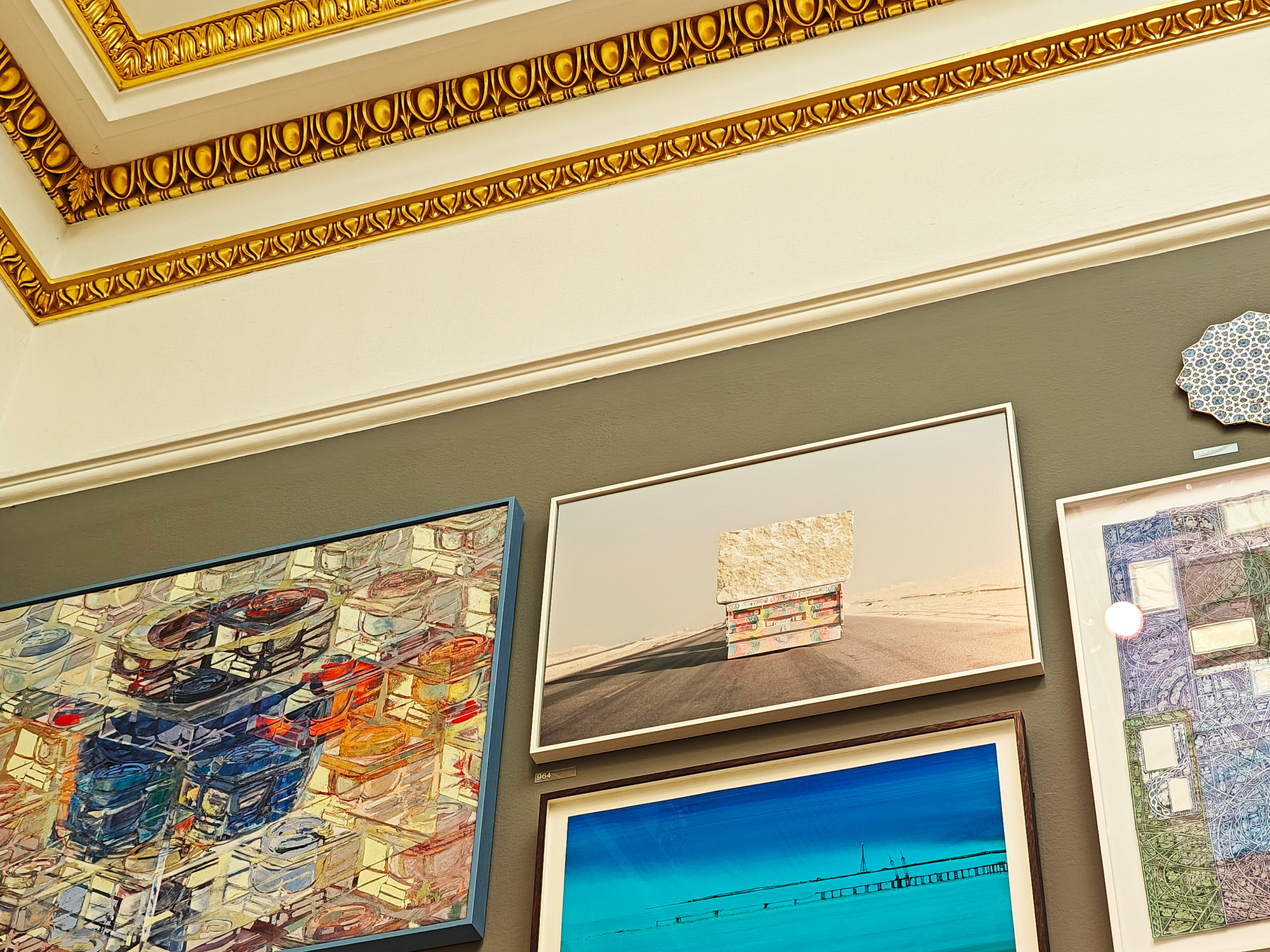
Building the New Capital in Egyptian Desert
digital photographic print
by Martin Migeon
edition of 20 at £640
www.martinmigeon.com
︎ @martinmigeon
Not all construction is presented so violently, though a force and power can still be present within.
As part of his wider whatwehave.co project - “an online repository of photographs, videos and conversations, about the current making of architecture in large and rapidly expanding cities” - Martin Migeon’s photograph of an uncanny moment of seemingly-halted desert stone-transportation speaks to the romance, dystopia, energy, and power of constructing new cities.
Taken in the Egyptian desert in rich, clear light, the lump stands like a roadblock in an otherwise empty site of change.
As part of his wider whatwehave.co project - “an online repository of photographs, videos and conversations, about the current making of architecture in large and rapidly expanding cities” - Martin Migeon’s photograph of an uncanny moment of seemingly-halted desert stone-transportation speaks to the romance, dystopia, energy, and power of constructing new cities.
Taken in the Egyptian desert in rich, clear light, the lump stands like a roadblock in an otherwise empty site of change.
Also seemingly halted mid-process is Catherine Purves’ alluring spectre of an architectural drawing. By using various screen printing, stencilling, and printmaking processes onto metalwork, the artist creates what appear to be pencil drawings with a deeper incision and presence.
The work’s name, Halfway, may be a meaningful nod to the modernist architectural agenda layered within, and a possible hope for a future that builds upon it, or it may be as simple as an acknowledgement that no drawing is really complete, and even by the time it was submitted to the Royal Acadamy judging panel it was still only as half complete as any drawing can ever be.
The work’s name, Halfway, may be a meaningful nod to the modernist architectural agenda layered within, and a possible hope for a future that builds upon it, or it may be as simple as an acknowledgement that no drawing is really complete, and even by the time it was submitted to the Royal Acadamy judging panel it was still only as half complete as any drawing can ever be.
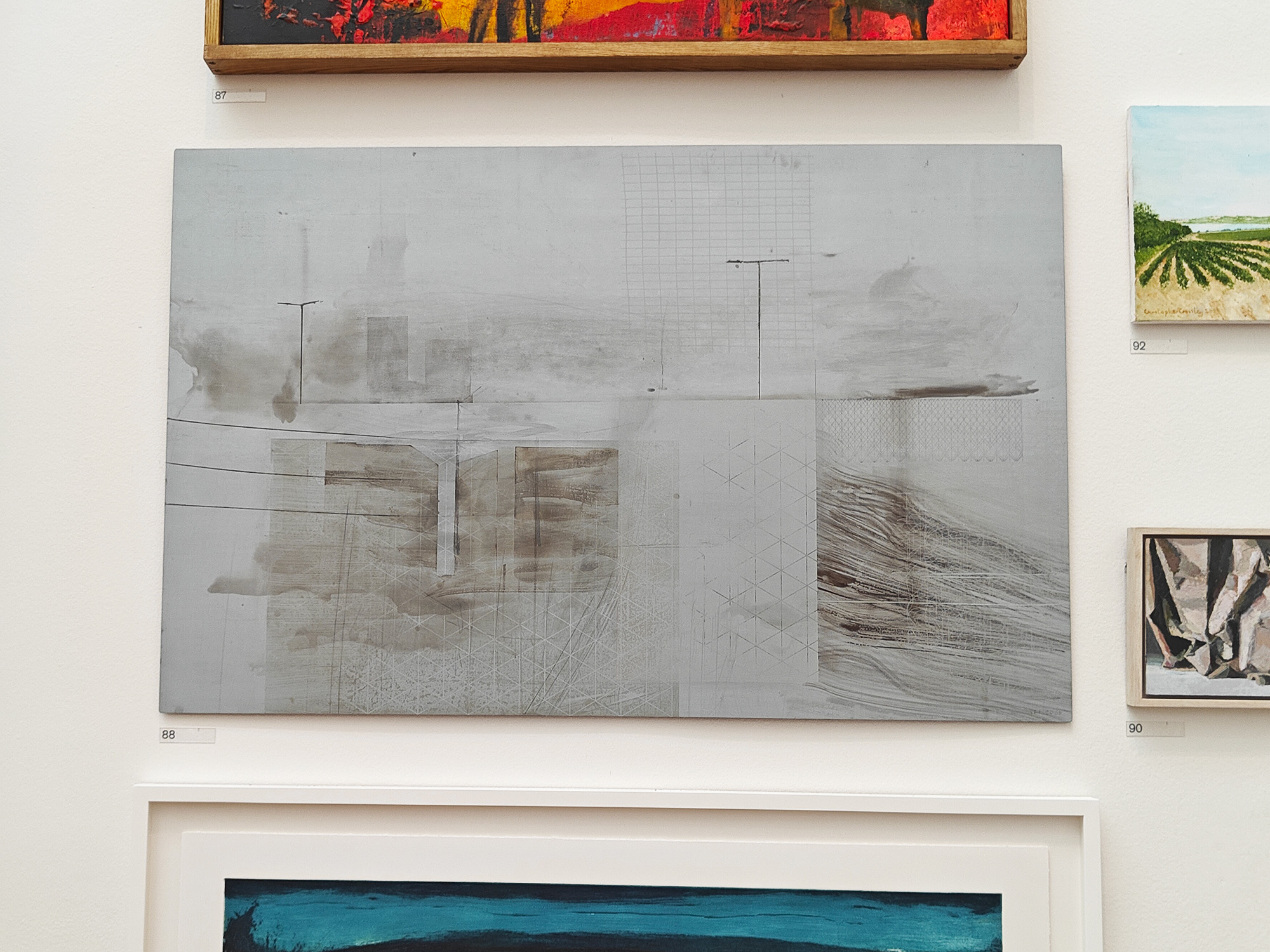
Halfway
screenprint, patination on zinc and steel
by Catherine Purves
£1,900
www.catherinemackaypurves.co.uk

Souvenir from the Anthropocene
acrylic on aluminium
Claire Douglass
£85,000
www.claire-douglass.uk
︎ @
the_garden_of_earthly_delights
A work which can’t be accused of being spare in aesthetic ingredients is Claire Douglass’ Souvenir from the Anthropocene, part of her ongoing Boschian exploration of the imaginary town of Brumingdon - which may or may not be based in part on a certain Midlands city the artist works in.
In a largescale acrylic painting celebrating the best and worst of our neoliberal urban and political landscape there are countless details to discover, from Boris Johnson desperately gesticulating to a dwindling crowd, a council cleaner removing a Banksy mural, and a Ballardian fashion photoshoot of a model contorting around a junkyard car.
In a largescale acrylic painting celebrating the best and worst of our neoliberal urban and political landscape there are countless details to discover, from Boris Johnson desperately gesticulating to a dwindling crowd, a council cleaner removing a Banksy mural, and a Ballardian fashion photoshoot of a model contorting around a junkyard car.
Two large-format photographs are digitally fused in Daniel Hewitt’s personal recollections of his childhood Yorkshire landscape and brutalist London architecture. Drawing Ruskinian connections between such concrete architecture and craggy rocks, the artist is searching for a kind of sublime honesty.
An architectural photographer, Hewitt’s work here is suitably understated in scale and presence, as opposed to much architectural photography in the Summer Exhibition that is often printed large in the idea it may make it more compelling, but in content is in no way understated.
An architectural photographer, Hewitt’s work here is suitably understated in scale and presence, as opposed to much architectural photography in the Summer Exhibition that is often printed large in the idea it may make it more compelling, but in content is in no way understated.
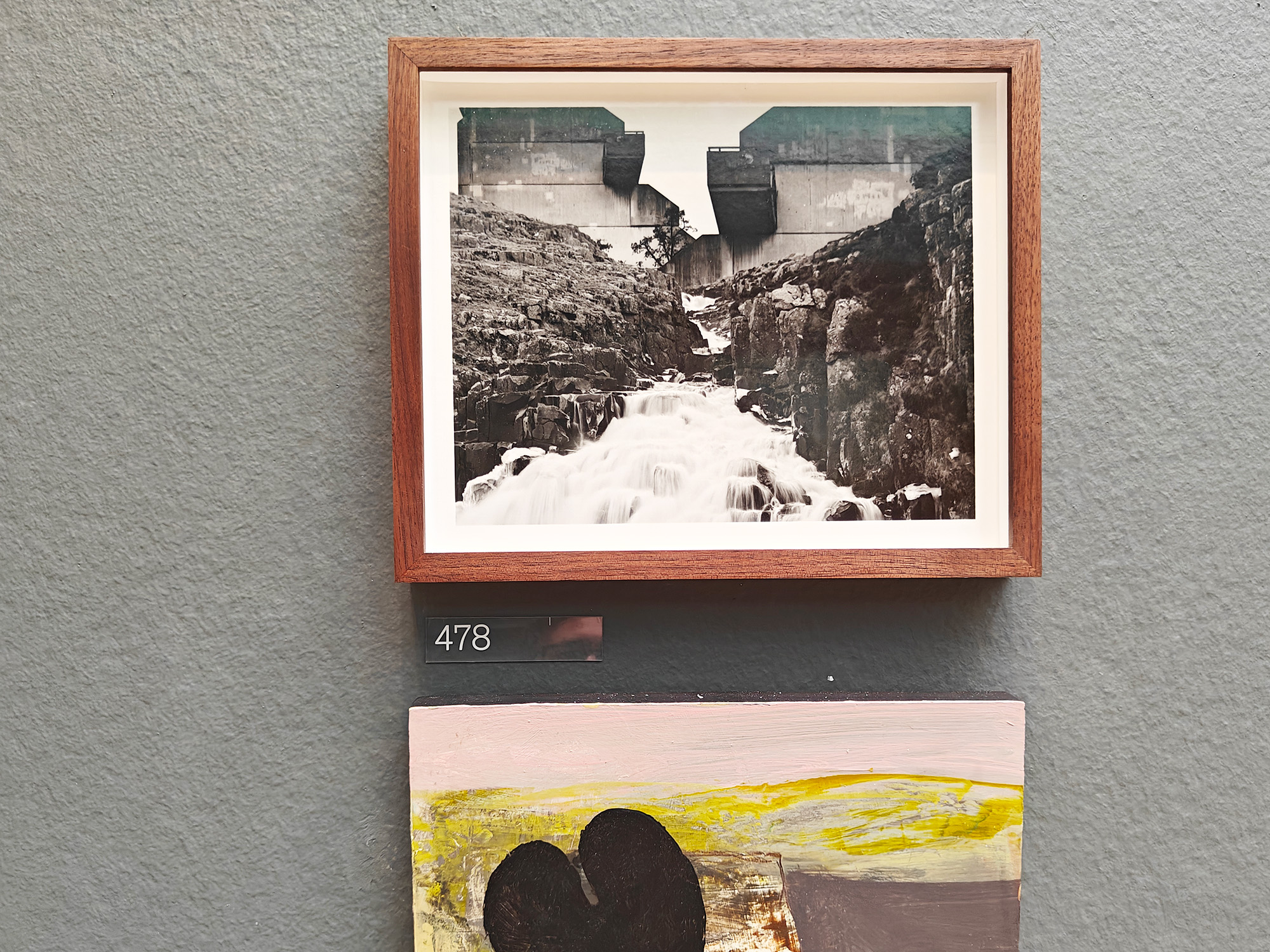
Geometry + Geology II: Alexandra & Ainsworth Estate +
Cauldron Snout
fibre based silver gelatin print
Daniel Hewitt
edition of 25 at £350
www.danielhewitt.com
︎ @brutus_beton
The work of Matt Lee also involves the ideas of collage and composite. Lee lived in Bangalore for over a decade, and these small cyanotype constructions are formed from landscape memories of the place.
Architectural forms overlay geological, and with a subtle sense of depth there is hint of that which cannot be seen in these tiny extracts of an overwhelmingly large city. The city itself is constantly changing, and so is Lee’s memory of the city he inhabited, both qualities present in the blue hue of the printing process.
Architectural forms overlay geological, and with a subtle sense of depth there is hint of that which cannot be seen in these tiny extracts of an overwhelmingly large city. The city itself is constantly changing, and so is Lee’s memory of the city he inhabited, both qualities present in the blue hue of the printing process.
Icelandic-born artist Baldvin Ringsted presents a poetic imaginary environment formed of cross-stitch. The scene is unlikely, with distant mountains sat behind seemingly British council houses, and a cathedral crashing into a cottage.
It is an amalgam of various found cross-stitch works, carefully reconfigured together into a new kind of jagged landscape. Ringsted’s practice traverses various media from sculpture and sound to paintings and video, but always with a sense of playful collage to create a new from unexpected fragments.
It is an amalgam of various found cross-stitch works, carefully reconfigured together into a new kind of jagged landscape. Ringsted’s practice traverses various media from sculpture and sound to paintings and video, but always with a sense of playful collage to create a new from unexpected fragments.
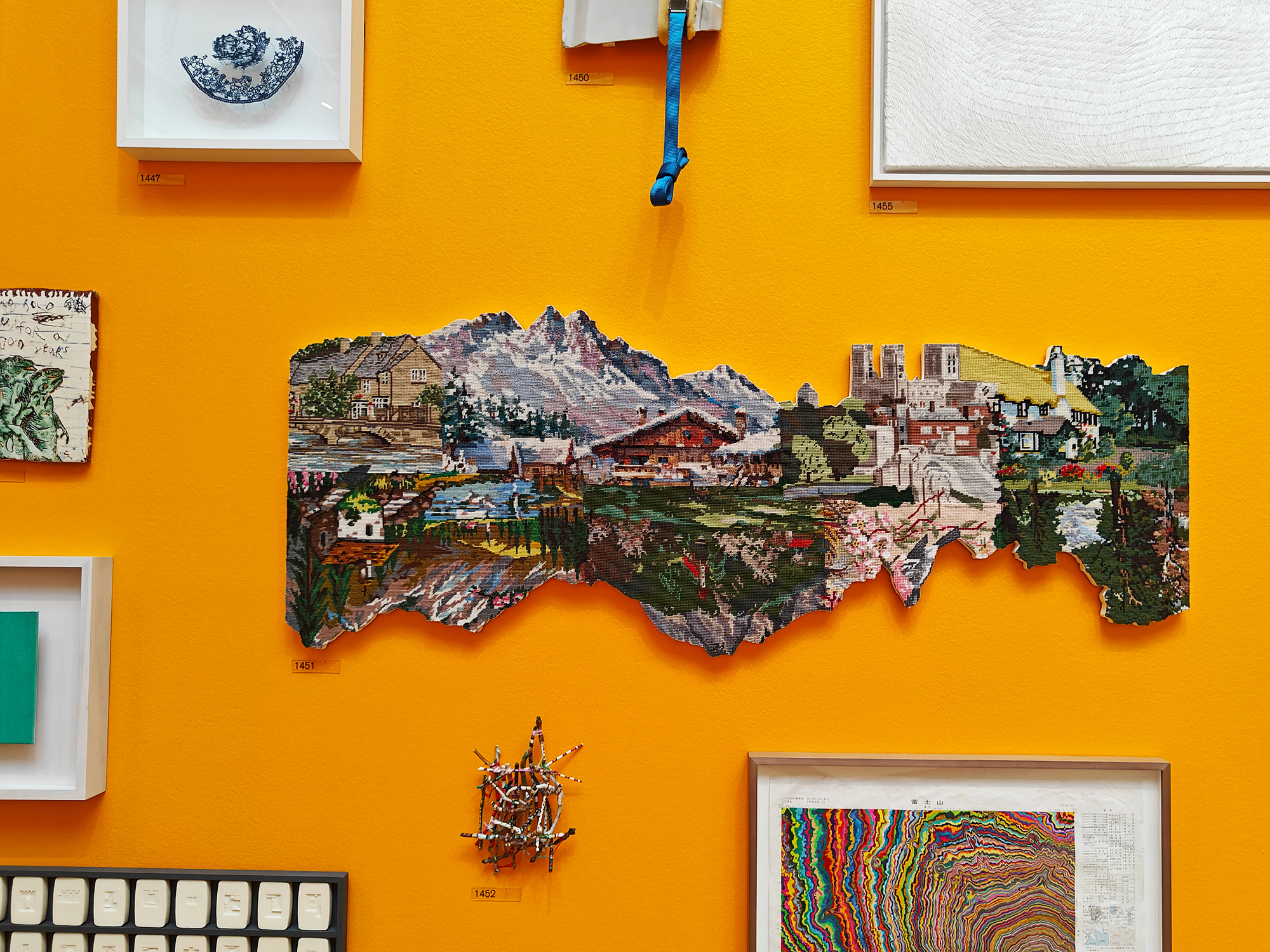
Wayfarer
found cross-stitch works, acrylic, wood
Baldvin Ringsted
£3,800
www.baldvinringsted.com
︎ @baldvinringsted
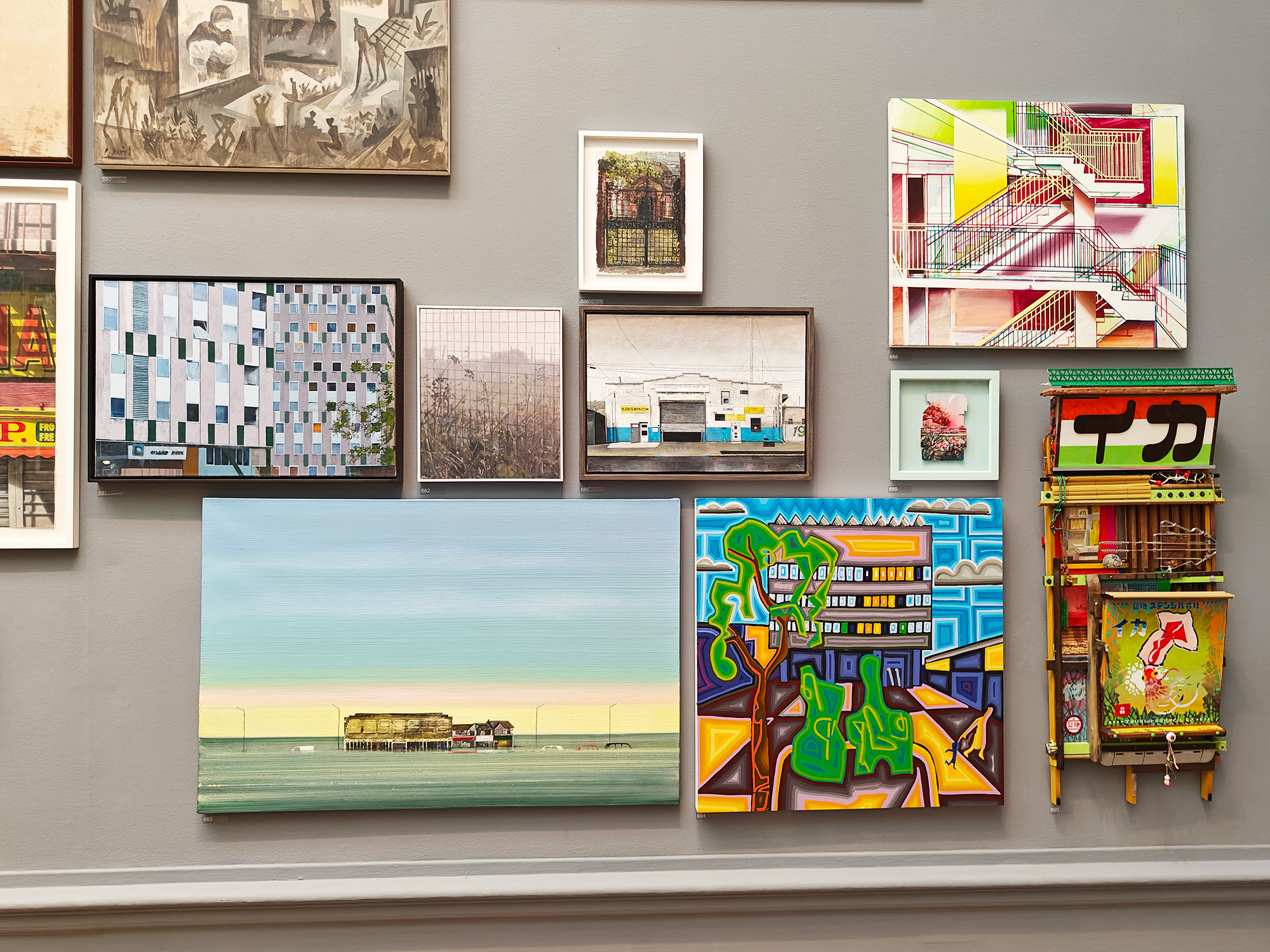
Skinner, Bailey and Lubetkin, Cranbrook Estate, Bethnal
Green
oil
Peter Wylie
£4,450
www.peter-wylie.com
︎ @eastofwylie
Fence
oil on panel
Kate Sherman
£1,200
www.kateshermanpaintings.co.uk
︎ @kateshermanart
U Haul
oil
Celia Hegedus
£5,500
︎ @celiahegedus
Underneath City Life: Goodfellas 2
oil
Jock McFadyen RA
£30,0000
www.jockmcfadyen.com
︎ @jockmcfadyenpainter
Chelsea School of Art, Manresa Road
signwriters’ enamel on timber
Bob and Roberta Smith RA
£14,000
www.bobandrobertasmith.co.uk
︎ @bobandrobertasmith
Last June, recessed.space wrote about the work of artist Hurvin Anderson’s exhibited at Hepworth Wakefield (see 00107). Here, Anderson becomes curator with a Royal Academy room packed with architectural and interior interest.
There is one suite of images that speaks richly to the weird collisions of such an open-call. Two large canvases from Members of the Academy sit under three images from those who applied along with 16,498 others for inclusion in the annual show.
Jock McFayden portrays a sunken Americana town lost on the horizon, while Bob and Roberta Smith present a pop-infused rendering of the new Herzog & de Meuron-designed RCA building in Battersea. Both are widely known, Members of the Royal Academy, expensive to purchase, and shown every year in the Summer Exhibition.
But it is the three images above that sing richer to how our urbanscape is read and considered through paint. Peter Wylie’s compressed oil vantage of Bethnal Green’s Cranbrook Estate and Celia Hegedus U Haul garage rendered in an Ed Ruscha-like flatness, are separated by a detail of fencing by Kate Sherman.
Altogether, this triptych conveys a mood of modern urbanity with a totally different energy to the more celebrated artist beneath.
There is one suite of images that speaks richly to the weird collisions of such an open-call. Two large canvases from Members of the Academy sit under three images from those who applied along with 16,498 others for inclusion in the annual show.
Jock McFayden portrays a sunken Americana town lost on the horizon, while Bob and Roberta Smith present a pop-infused rendering of the new Herzog & de Meuron-designed RCA building in Battersea. Both are widely known, Members of the Royal Academy, expensive to purchase, and shown every year in the Summer Exhibition.
But it is the three images above that sing richer to how our urbanscape is read and considered through paint. Peter Wylie’s compressed oil vantage of Bethnal Green’s Cranbrook Estate and Celia Hegedus U Haul garage rendered in an Ed Ruscha-like flatness, are separated by a detail of fencing by Kate Sherman.
Altogether, this triptych conveys a mood of modern urbanity with a totally different energy to the more celebrated artist beneath.
recessed.space wrote that Carey Young’s 2023 solo exhibition at Modern Art Oxford it was “poetic and provocative” (see 00099). It is a joy, then, that the artist was selected by Turner Prize winning artist Veronica Ryan for inclusion in the Summer Exhibition.
The only artist afforded an entire room to their work, Young’s film The Vision Machine, also presented in Oxford, is a welcome escape from the salon-style intensity of the show.
The work documents the female workers at SIGMA’s Japanese factory, where lenses for photographic and cinematic cameras are made and tested - a soft and considerate study of labour and looking.
The only artist afforded an entire room to their work, Young’s film The Vision Machine, also presented in Oxford, is a welcome escape from the salon-style intensity of the show.
The work documents the female workers at SIGMA’s Japanese factory, where lenses for photographic and cinematic cameras are made and tested - a soft and considerate study of labour and looking.
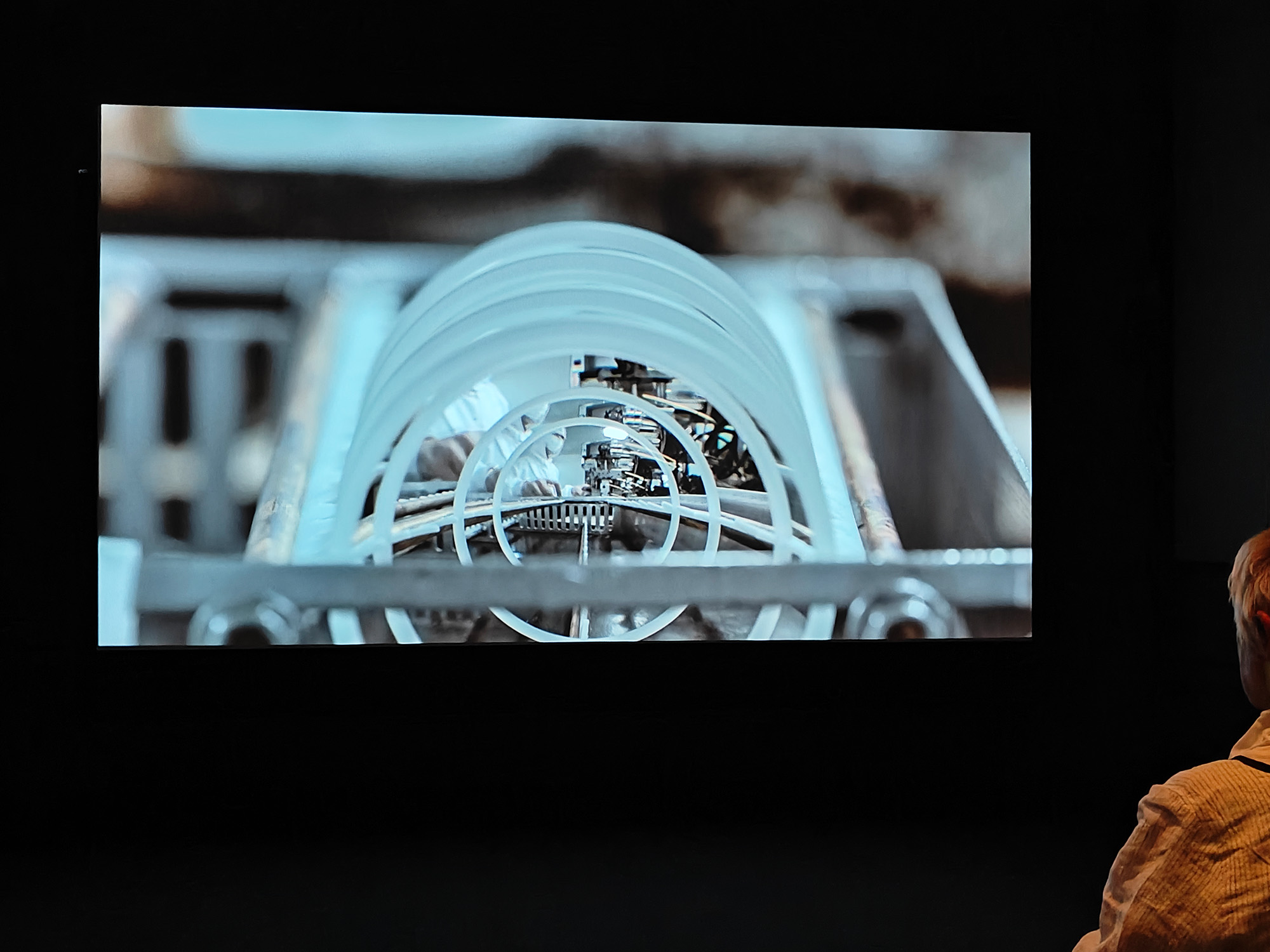
The Vision Machine, 2020
single-channel video (from 4k); 16:9 format, duration: 13 minutes, 27 seconds
Carey Young
www.careyyoung.com
︎ @ccareyyoung
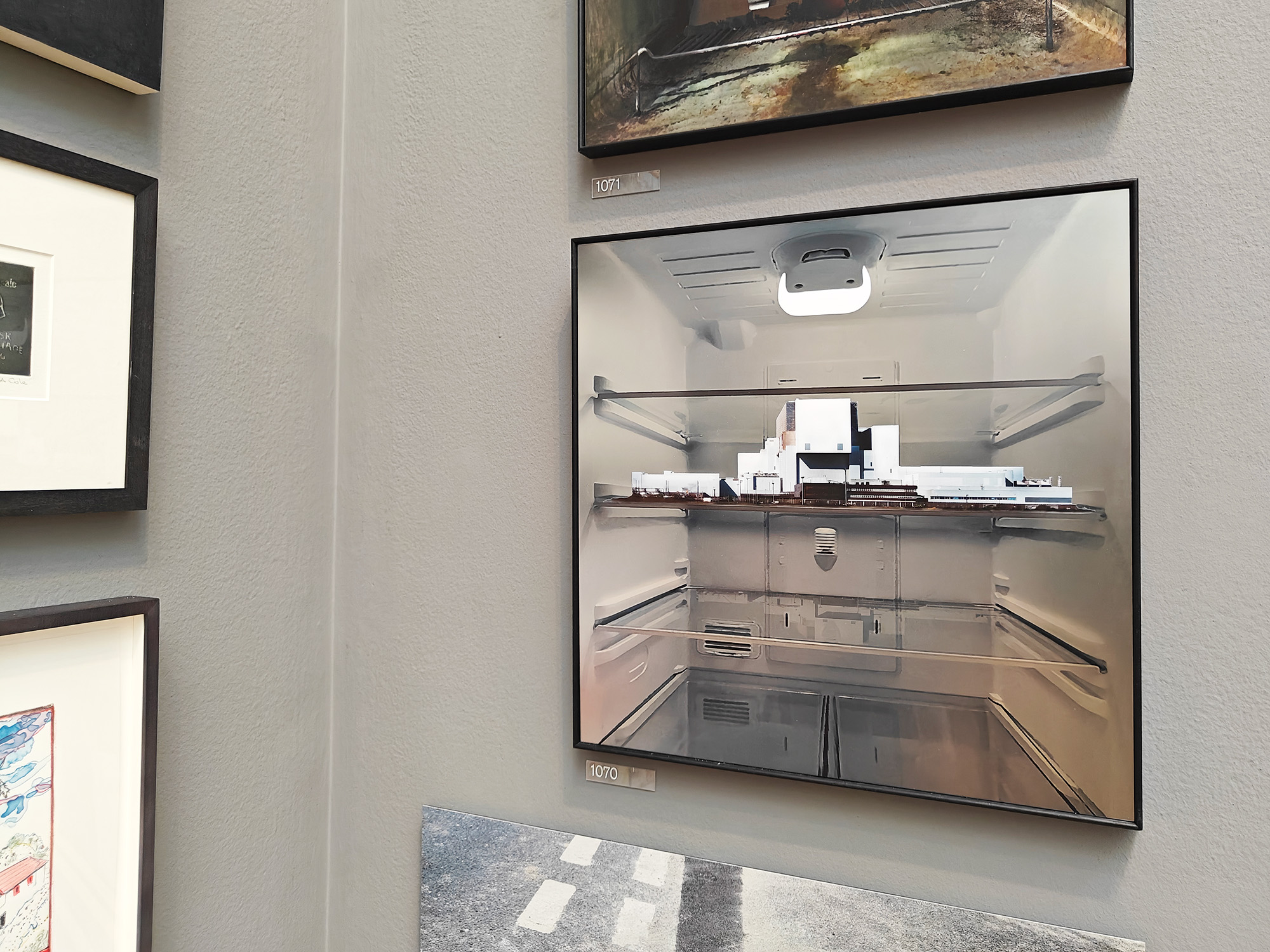
Fridge Fusion
digital photomontage, metal print
Esther Cohen
edition of 10 at £875
www.esthercohen.co.uk
︎ @esthercohenartist
An altogether more unexpected scientific encounter is found in Esther Cohen’s photomontage, placing Torness Nuclear Power Station inside a fridge.
Part of the artist’s wider Electric Landscape series, the image is a play on both scale but also the dependency of the everyday on that of such scientific advances. It is a reflexive conversation between the mundane and an ecosystem it is part of, with wit and humour.
Part of the artist’s wider Electric Landscape series, the image is a play on both scale but also the dependency of the everyday on that of such scientific advances. It is a reflexive conversation between the mundane and an ecosystem it is part of, with wit and humour.





